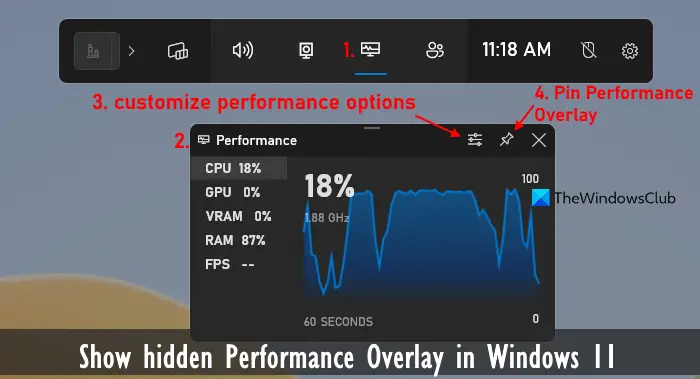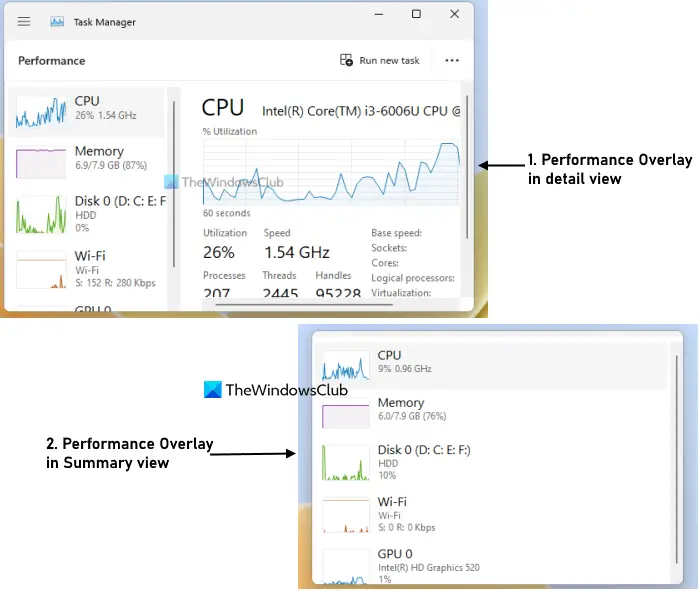How to show hidden performance overlays in Windows 11
In this tutorial, we will help you reveal hidden performance overlays in Windows 11. Using Windows 11’s Performance Overlay feature, you’ll be able to monitor your system resources in real time. You can view real-time CPU usage, disk usage, GPU usage, RAM usage, etc. on your computer screen. This is convenient when you are playing games or using large graphics programs (such as video editors) and need to check how much system performance is affected when using a specific program.
While there are some excellent free software available for monitoring system performance, and some built-in tools like Resource Monitor can be used to check system performance, the performance overlay feature also has its advantages. For example, you don't need to leave the program or app you're currently using, and you don't need to repeatedly monitor system performance. You can continue using the application and immediately see how your PC is performing.
How to show hidden performance overlays in Windows 11
There are two different native ways you can show hidden performance overlays on your Windows 11 PC. these are:
1] Use Game Bar to show hidden performance overlays

In Windows 11, the Game Bar (formerly Xbox Game Bar) feature provides a variety of useful functions, such as taking screenshots, starting video recording while gaming, and viewing real-time system performance. In addition to monitoring CPU, RAM and GPU usage, it can also display in-game FPS and VRAM usage, which makes this feature even more powerful and useful. Through Game Bar, players can more easily monitor game performance and make necessary adjustments for a smoother, smoother gaming experience.
Before you start using this feature, you need to make sure you have the Game Bar feature enabled or turned on. To do this, open the Settings app (Win i), then navigate to Game Bar and enable the Allow controller to open Game Bar option. Once you complete these steps, here's how you can use Game Bar to show hidden performance overlays.
To exit the performance overlay, press the Win G hotkey, select the performance overlay's unlock icon, and close it.
Read: How to Run Computer Performance Benchmarks on a Windows PC
2] Use Task Manager to show hidden performance overlays

Windows 11 Task Manager is another option to show hidden performance overlays on your computer. You can use it to view real-time CPU usage, network or Wi-Fi usage, disk usage, memory (or RAM) and GPU usage, and graphs. For each indicator, it shows additional details or information. For example, for memory, it shows total memory in use, available memory, cached memory, paged pool, non-paged pool, memory speed, etc.
Now you can monitor performance metrics and continue using other programs. To undo the changes, access Task Manager's Settings options in the Performance overlay and uncheck the Always on top option. You can then close Task Manager.
Tip: You can also place your mouse cursor over Task Manager's system tray icon to view real-time CPU, network, GPU, and memory usage while Task Manager is open or running.
Hope this helps.
How to open the performance tab in Windows 11?
If you want to open the Performance tab in Task Manager on your Windows 11 PC, use the navigation section on the left. There, select the "Performance" tab available under the "Processes" menu or tabs. And if you want to open the Performance Monitor tool in Windows 11, you can use the search box or type perfmon in the run command box and press Enter.
How to monitor PC performance while gaming?
There are some of the best free game monitoring software for Windows PC that you can use to monitor your PC performance while gaming. Some good examples of these tools are MSI Afterburner, NVIDIA GeForce Experience Performance Monitoring, GPU-Z, HWMonitor, etc. You can also use Windows 11’s Game Bar Performance Monitor overlay feature to monitor system performance.
Read next: How to use Performance Monitor in Windows PC.
The above is the detailed content of How to show hidden performance overlays in Windows 11. For more information, please follow other related articles on the PHP Chinese website!

Hot AI Tools

Undresser.AI Undress
AI-powered app for creating realistic nude photos

AI Clothes Remover
Online AI tool for removing clothes from photos.

Undress AI Tool
Undress images for free

Clothoff.io
AI clothes remover

Video Face Swap
Swap faces in any video effortlessly with our completely free AI face swap tool!

Hot Article

Hot Tools

Notepad++7.3.1
Easy-to-use and free code editor

SublimeText3 Chinese version
Chinese version, very easy to use

Zend Studio 13.0.1
Powerful PHP integrated development environment

Dreamweaver CS6
Visual web development tools

SublimeText3 Mac version
God-level code editing software (SublimeText3)

Hot Topics
 Can I install mysql on Windows 7
Apr 08, 2025 pm 03:21 PM
Can I install mysql on Windows 7
Apr 08, 2025 pm 03:21 PM
Yes, MySQL can be installed on Windows 7, and although Microsoft has stopped supporting Windows 7, MySQL is still compatible with it. However, the following points should be noted during the installation process: Download the MySQL installer for Windows. Select the appropriate version of MySQL (community or enterprise). Select the appropriate installation directory and character set during the installation process. Set the root user password and keep it properly. Connect to the database for testing. Note the compatibility and security issues on Windows 7, and it is recommended to upgrade to a supported operating system.
 How to solve mysql cannot connect to local host
Apr 08, 2025 pm 02:24 PM
How to solve mysql cannot connect to local host
Apr 08, 2025 pm 02:24 PM
The MySQL connection may be due to the following reasons: MySQL service is not started, the firewall intercepts the connection, the port number is incorrect, the user name or password is incorrect, the listening address in my.cnf is improperly configured, etc. The troubleshooting steps include: 1. Check whether the MySQL service is running; 2. Adjust the firewall settings to allow MySQL to listen to port 3306; 3. Confirm that the port number is consistent with the actual port number; 4. Check whether the user name and password are correct; 5. Make sure the bind-address settings in my.cnf are correct.
 MySQL can't be installed after downloading
Apr 08, 2025 am 11:24 AM
MySQL can't be installed after downloading
Apr 08, 2025 am 11:24 AM
The main reasons for MySQL installation failure are: 1. Permission issues, you need to run as an administrator or use the sudo command; 2. Dependencies are missing, and you need to install relevant development packages; 3. Port conflicts, you need to close the program that occupies port 3306 or modify the configuration file; 4. The installation package is corrupt, you need to download and verify the integrity; 5. The environment variable is incorrectly configured, and the environment variables must be correctly configured according to the operating system. Solve these problems and carefully check each step to successfully install MySQL.
 Solutions to the errors reported by MySQL on a specific system version
Apr 08, 2025 am 11:54 AM
Solutions to the errors reported by MySQL on a specific system version
Apr 08, 2025 am 11:54 AM
The solution to MySQL installation error is: 1. Carefully check the system environment to ensure that the MySQL dependency library requirements are met. Different operating systems and version requirements are different; 2. Carefully read the error message and take corresponding measures according to prompts (such as missing library files or insufficient permissions), such as installing dependencies or using sudo commands; 3. If necessary, try to install the source code and carefully check the compilation log, but this requires a certain amount of Linux knowledge and experience. The key to ultimately solving the problem is to carefully check the system environment and error information, and refer to the official documents.
 How to copy and paste mysql
Apr 08, 2025 pm 07:18 PM
How to copy and paste mysql
Apr 08, 2025 pm 07:18 PM
Copy and paste in MySQL includes the following steps: select the data, copy with Ctrl C (Windows) or Cmd C (Mac); right-click at the target location, select Paste or use Ctrl V (Windows) or Cmd V (Mac); the copied data is inserted into the target location, or replace existing data (depending on whether the data already exists at the target location).
 Unable to access mysql from terminal
Apr 08, 2025 pm 04:57 PM
Unable to access mysql from terminal
Apr 08, 2025 pm 04:57 PM
Unable to access MySQL from the terminal may be due to: MySQL service not running; connection command error; insufficient permissions; firewall blocks connection; MySQL configuration file error.
 Can mysql run on Windows
Apr 08, 2025 pm 01:54 PM
Can mysql run on Windows
Apr 08, 2025 pm 01:54 PM
Running MySQL on Windows is feasible, but challenges such as port conflicts, permission issues, and environment variable settings need to be considered. Installation issues can be solved by customizing configuration files, adjusting user permissions, and setting environment variables correctly. Additionally, the appropriate storage engine should be selected, tweaked configuration files, and SSDs should be used to optimize performance.
 Can vs code run in Windows 8
Apr 15, 2025 pm 07:24 PM
Can vs code run in Windows 8
Apr 15, 2025 pm 07:24 PM
VS Code can run on Windows 8, but the experience may not be great. First make sure the system has been updated to the latest patch, then download the VS Code installation package that matches the system architecture and install it as prompted. After installation, be aware that some extensions may be incompatible with Windows 8 and need to look for alternative extensions or use newer Windows systems in a virtual machine. Install the necessary extensions to check whether they work properly. Although VS Code is feasible on Windows 8, it is recommended to upgrade to a newer Windows system for a better development experience and security.






